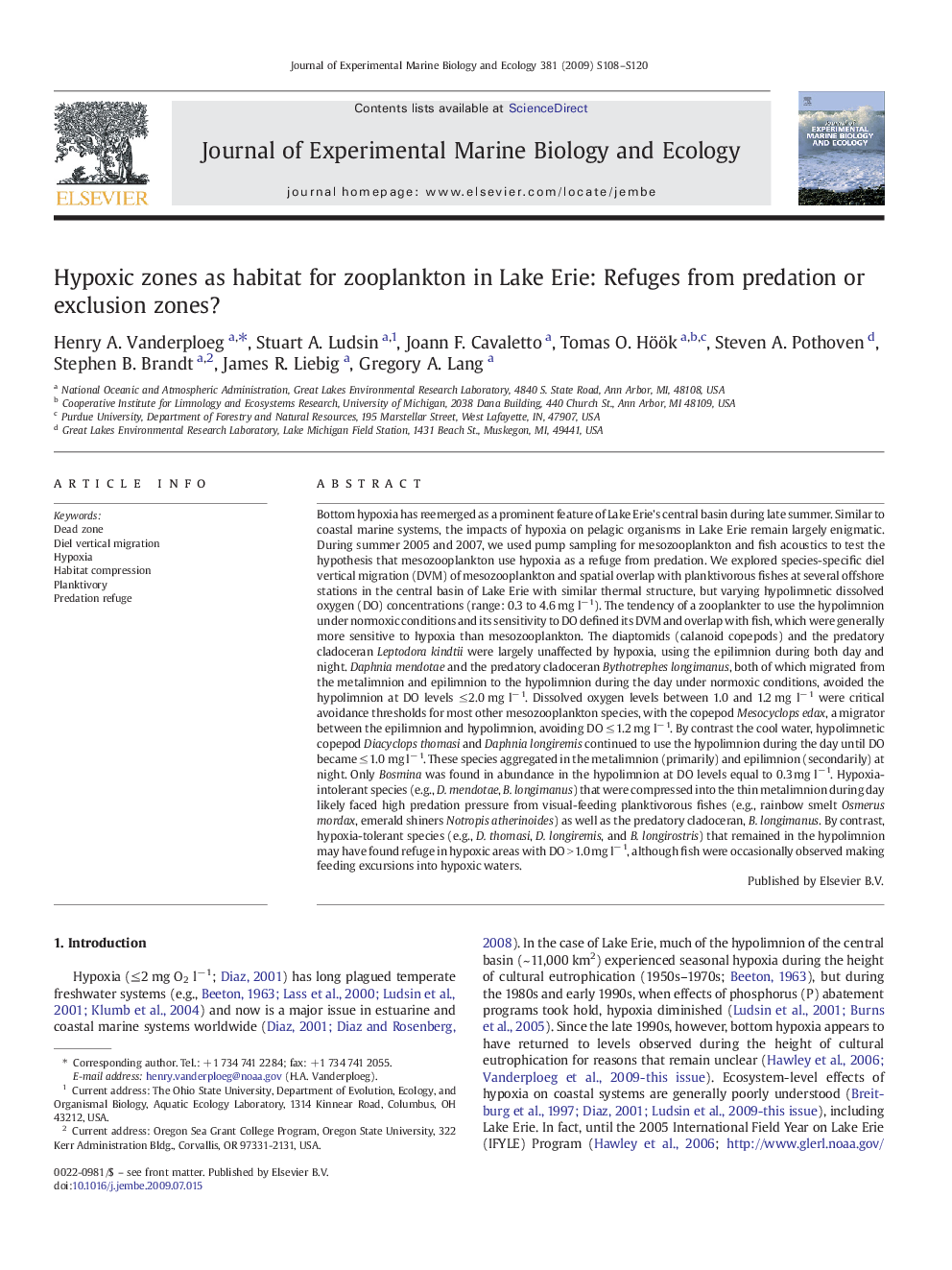| کد مقاله | کد نشریه | سال انتشار | مقاله انگلیسی | نسخه تمام متن |
|---|---|---|---|---|
| 4396798 | 1305843 | 2009 | 13 صفحه PDF | دانلود رایگان |
عنوان انگلیسی مقاله ISI
Hypoxic zones as habitat for zooplankton in Lake Erie: Refuges from predation or exclusion zones?
دانلود مقاله + سفارش ترجمه
دانلود مقاله ISI انگلیسی
رایگان برای ایرانیان
کلمات کلیدی
موضوعات مرتبط
علوم زیستی و بیوفناوری
علوم کشاورزی و بیولوژیک
علوم آبزیان
پیش نمایش صفحه اول مقاله

چکیده انگلیسی
Bottom hypoxia has reemerged as a prominent feature of Lake Erie's central basin during late summer. Similar to coastal marine systems, the impacts of hypoxia on pelagic organisms in Lake Erie remain largely enigmatic. During summer 2005 and 2007, we used pump sampling for mesozooplankton and fish acoustics to test the hypothesis that mesozooplankton use hypoxia as a refuge from predation. We explored species-specific diel vertical migration (DVM) of mesozooplankton and spatial overlap with planktivorous fishes at several offshore stations in the central basin of Lake Erie with similar thermal structure, but varying hypolimnetic dissolved oxygen (DO) concentrations (range: 0.3 to 4.6 mg lâ1). The tendency of a zooplankter to use the hypolimnion under normoxic conditions and its sensitivity to DO defined its DVM and overlap with fish, which were generally more sensitive to hypoxia than mesozooplankton. The diaptomids (calanoid copepods) and the predatory cladoceran Leptodora kindtii were largely unaffected by hypoxia, using the epilimnion during both day and night. Daphnia mendotae and the predatory cladoceran Bythotrephes longimanus, both of which migrated from the metalimnion and epilimnion to the hypolimnion during the day under normoxic conditions, avoided the hypolimnion at DO levels â¤Â 2.0 mg lâ 1. Dissolved oxygen levels between 1.0 and 1.2 mg lâ 1 were critical avoidance thresholds for most other mesozooplankton species, with the copepod Mesocyclops edax, a migrator between the epilimnion and hypolimnion, avoiding DO â¤Â 1.2 mg lâ 1. By contrast the cool water, hypolimnetic copepod Diacyclops thomasi and Daphnia longiremis continued to use the hypolimnion during the day until DO became â¤Â 1.0 mg lâ 1. These species aggregated in the metalimnion (primarily) and epilimnion (secondarily) at night. Only Bosmina was found in abundance in the hypolimnion at DO levels equal to 0.3 mg lâ 1. Hypoxia-intolerant species (e.g., D. mendotae, B. longimanus) that were compressed into the thin metalimnion during day likely faced high predation pressure from visual-feeding planktivorous fishes (e.g., rainbow smelt Osmerus mordax, emerald shiners Notropis atherinoides) as well as the predatory cladoceran, B. longimanus. By contrast, hypoxia-tolerant species (e.g., D. thomasi, D. longiremis, and B. longirostris) that remained in the hypolimnion may have found refuge in hypoxic areas with DO > 1.0 mg lâ 1, although fish were occasionally observed making feeding excursions into hypoxic waters.
ناشر
Database: Elsevier - ScienceDirect (ساینس دایرکت)
Journal: Journal of Experimental Marine Biology and Ecology - Volume 381, Supplement, 1 December 2009, Pages S108-S120
Journal: Journal of Experimental Marine Biology and Ecology - Volume 381, Supplement, 1 December 2009, Pages S108-S120
نویسندگان
Henry A. Vanderploeg, Stuart A. Ludsin, Joann F. Cavaletto, Tomas O. Höök, Steven A. Pothoven, Stephen B. Brandt, James R. Liebig, Gregory A. Lang,